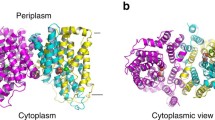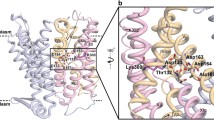Abstract
Vibrio cholerae is the infectious agent of the deadly diarrheal disease, cholera. Na+ ion homeostasis is believed to play a key role in both physiology and pathogenicity of this bacterium. However, molecular mechanisms of sodium exchange in V. cholerae are still poorly understood. In the present work a gene encoding an unusual Na+/H+ antiporter, nhaD, was identified in the V. cholerae genome. nhaD was cloned from Vibrio cholerae and expressed in Escherichia coli. The antiporter functioned in an E. coli nhaAnhaB mutant strain to confer resistance to LiCl and NaCl. When assayed in inside-out subbacterial vesicles, V. cholerae NhaD demonstrated high affinity for Na+ ions (1.1 mM Na+ was required for the half-maximal response at the pH-optimum). The most striking feature of Vc-NhaD is a unique pH-profile of its activity with a sharp maximum at pH 8.0, different from that of any bacterial sodium-proton antiporter described so far. The difference is rationalized as being the result of a His to Arg substitution in a putative pH sensing residue.
Similar content being viewed by others
References
Häse C, Mekalanos J: Effects of changes in membrane sodium flux on virulence gene expression in Vibrio cholerae. Proc Natl Acad Sci USA 96: 3183–3187, 1999
Häse C, Mekalanos J: TcpP protein is a positive regulator of virulence gene expression in Vibrio cholerae. Proc Natl Acad Sci USA 95: 730–734, 1998
Kojima S, Yamamoto K, Kawagishi I, Homma M: The polar flagellar motor of Vibrio cholerae is driven by an Na+ motive force. J Bacteriol 181: 1927–1930, 1999
Gosink K, Häse C: Requirements for conversion of the Na+-driven flagellar motor of Vibrio cholerae to the H+-driven motor of Escherichia coli. J Bacteriol 182: 4234–4240, 2000
Vimont S, Berche P: NhaA, an Na+/H+ antiporter involved in environmental survival of Vibrio cholerae. J Bacteriol 182: 2937–2944, 2000
Gardel C, Mekalanos J: Alterations in Vibrio cholerae motility phenotypes correlate with changes in virulence factor expression. Infect Immun 64: 2246–2255, 1996
Bakeeva L, Chumakov K, Drachev A, Metlina A, Skulachev V: The sodium cycle. III. Vibrio alginolyticus resembles Vibrio cholerae and some other vibriones by flagellar motor and ribosomal 5S-RNA structures. Biochim Biophys Acta 850: 466–472, 1986
Avetisyan A, Bogachev A, Murtasina R, Skulachev V: ATP-driven Na+ transport and Na+-dependent ATP synthesis in Escherichia coli grown at low ΔµH+. FEBS Lett 317: 267–270, 1993
Dibrov P, Lazarova R, Skulachev V, Verkhovskaya M: The sodium cycle. II. Na+-coupled oxidative phosphorylation in Vibrio alginolyticus cells. Biochim Biophys Acta 850: 458–465, 1986
Dimroth P, Wang H, Grabe M, Oster G: Energy transduction in the sodium F-ATPase of Propionigenium modestum. Proc Natl Acad Sci USA 96: 4924–4929, 1999
Dibrov P: The role of sodium ion transport in Escherichia coli energetics. Biochim Biophys Acta 1056: 209–224, 1991
Atsumi T, McCarter L, Imae Y: Polar and lateral flagellar motors of marine Vibrio are driven by different ion-motive forces. Nature 355: 182–184, 1992
Dibrov P, Kostyrko V, Lazarova R, Skulachev V, Smirnova I: The sodium cycle. I. Na-dependent motility and modes of membrane energization in marine alkalotolerant bacterium Vibrio alginolyticus. Biochim Biophys Acta 850: 449–457, 1986
Krulwich T: Na+/H+ antiporters. Biochim Biophys Acta 726: 245–264, 1983
Kuroda T, Shimamoto T, Inaba K, Tsuda M, Tsuchiya T: Properties and sequence of the NhaA Na+/H+ antiporter of Vibrio parahaemolyticus. J Biochem (Tokyo) 116: 1030–1038, 1994
Padan E, Schuldiner S: Molecular physiology of Na+/H+ antiporters, key transporters in circulation of Na+ and H+ in cells. Biochim Biophys Acta 1185: 129–151, 1994
Padan E, Schuldiner S: Bacterial Na+/H+ antiporters — molecular biology, biochemistry, and physiology. In: W. Konings, R. Kaback, J. Lolkema (eds). The Handbook of Biological Physics, Vol. II. Transport Processes in Membranes. Elsevier Science, Amsterdam, The Netherlands, 1996, pp 501–531
Nozaki K, Inaba K, Kuroda T, Tsuda M, Tsuchiya T: Cloning and sequencing of the gene for Na+/H+ antiporter of Vibrio parahaemolyticus. Biochem Biophys Res Commun 222: 774–779, 1996
Nakamura T, Komano Y, Itaya E, Tsukamoto K, Tsuchiya T: Cloning and sequencing of an Na+/H+ antiporter gene from the marine bacterium Vibrio alginolyticus. Biochim Biophys Acta 1190: 465–468, 1994
Nakamura T, Enomoto H, Unemoto T: Cloning and sequencing of nhaB gene encoding an Na+/H+ antiporter from Vibrio alginolyticus. Biochim Biophys Acta 1275 157–160, 1996
Nozaki K, Kuroda T, Mizushima T, Tsuchiya T: A new Na+/H+ antiporter, NhaD, of Vibrio parahaemolyticus. Biochim Biophys Acta 1369: 213–220, 1998
Claros M, von Heijne G: TopPred II: An improved software for membrane protein structure predictions. Comp Appl Biosci 10: 685–686, 1994
Chen W, Kuo T: A simple and rapid method for the preparation of Gram-negative bacterial genomic DNA. Nucleic Acid Res 21: 2260, 1993
Harel-Bronstein M, Dibrov P, Olami Y, Pinner E, Schuldiner S, Padan E: MH1, a second-site revertant of an Escherichia coli mutant lacking Na+/H+ antiporters (ΔnhaAΔnhaB), regains Na+ resistance and a capacity to excrete Na+ in a ΔµH+-independent fashion. J Biol Chem 270: 3816–3822, 1995
Gerchman Y, Olami Y, Rimon A, Taglicht D, Schuldiner S, Padan E: Histidine-226 is part of the pH sensor of NhaA, a Na+/H+ antiporter in Escherichia coli. Proc Natl Acad Sci USA 90: 1212–1216, 1993
Olami Y, Rimon A, Gerchman Y, Rothman A, Padan E: Histidine 225, a residue of the NhaA — Na+/H+ antiporter of Escherichia coli is exposed and faces the cell exterior. J Biol Chem 272: 1761–1768, 1997
Booth J: Regulation of cytoplasmic pH in bacteria. Microbiol Rev 49: 359–378, 1985
Ikegami M, Takahashi H, Igarashi K, Kakinuma Y: Sodium ATPase and sodium/proton antiporter are not obligatory for sodium homeostasis of Enterococcus hirae at acid pH. Biosci Biotechnol Biochem 64: 1088–1092, 2000
Altschul S, Madden T, Schaffer A, Zhang J, Zheng Z, Miller W, Lipman D: Gapped BLAST and PSI-BLAST — A new generation of protein database search programs. Nucleic Acids Res 25: 3389–3402, 1997
Author information
Authors and Affiliations
Corresponding author
Rights and permissions
About this article
Cite this article
Dzioba, J., Ostroumov, E., Winogrodzki, A. et al. Cloning, functional expression in Escherichia coli and primary characterization of a new NA+/H+ antiporter, NhaD, of Vibrio cholerae . Mol Cell Biochem 229, 119–124 (2002). https://doi.org/10.1023/A:1017932829927
Issue Date:
DOI: https://doi.org/10.1023/A:1017932829927




